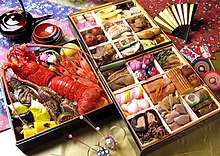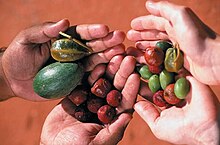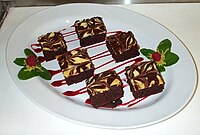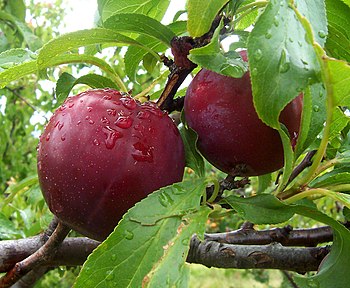Portal:Food
F o o d
A portal dedicated to food and foodways
Introduction


Food is any substance consumed by an organism for nutritional support. Food is usually of plant, animal, or fungal origin and contains essential nutrients such as carbohydrates, fats, proteins, vitamins, or minerals. The substance is ingested by an organism and assimilated by the organism's cells to provide energy, maintain life, or stimulate growth. Different species of animals have different feeding behaviours that satisfy the needs of their metabolisms and have evolved to fill a specific ecological niche within specific geographical contexts.
Omnivorous humans are highly adaptable and have adapted to obtain food in many different ecosystems. Humans generally use cooking to prepare food for consumption. The majority of the food energy required is supplied by the industrial food industry, which produces food through intensive agriculture and distributes it through complex food processing and food distribution systems. This system of conventional agriculture relies heavily on fossil fuels, which means that the food and agricultural systems are one of the major contributors to climate change, accounting for as much as 37% of total greenhouse gas emissions. (Full article...)
Cooking, also known as cookery or professionally as the culinary arts, is the art, science and craft of using heat to make food more palatable, digestible, nutritious, or safe. Cooking techniques and ingredients vary widely, from grilling food over an open fire, to using electric stoves, to baking in various types of ovens, reflecting local conditions.
Preparing food with heat or fire is an activity unique to humans. Archeological evidence of cooking fires from at least 300,000 years ago exists, but some estimate that humans started cooking up to 2 million years ago.
The expansion of agriculture, commerce, trade, and transportation between civilizations in different regions offered cooks many new ingredients. New inventions and technologies, such as the invention of pottery for holding and boiling of water, expanded cooking techniques. Some modern cooks apply advanced scientific techniques to food preparation to further enhance the flavor of the dish served. (Full article...)
Beat the Chefs is an American television cooking game show broadcast by Game Show Network (GSN) and hosted by Matt Rogers. The series features contestants preparing a home-cooked family recipe, while professional chefs Beau MacMillan, Antonia Lofaso and Jeff Henderson make the same recipe in an upscale restaurant version. The two dishes are then judged by a panel of food critics who are Christy Jordan and Brad A Johnson. The series premiered on August 23, 2012, and aired its last episode on November 26, 2012. (Full article...)
Selected article –
Bush tucker, also called bush food, is any food native to Australia and historically eaten by Indigenous Australians, the Aboriginal and Torres Strait Islander peoples, but it can also describe any native flora, fauna, or funga used for culinary or medicinal purposes, regardless of the continent or culture. Animal native foods include kangaroo, emu, witchetty grubs and crocodile, and plant foods include fruits such as quandong, kutjera, spices such as lemon myrtle and vegetables such as warrigal greens and various native yams.
Traditional Indigenous Australians' use of bushfoods has been severely affected by the settlement of Australia in 1788 and subsequent settlement by non-Indigenous peoples. The introduction of non-native foods, together with the loss of traditional lands, resulting in reduced access to native foods by Aboriginal people, and destruction of native habitat for agriculture, has accentuated the reduction in use. (Full article...)Selected cuisine -

Japanese cuisine encompasses the regional and traditional foods of Japan, which have developed through centuries of political, economic, and social changes. The traditional cuisine of Japan (Japanese: washoku) is based on rice with miso soup and other dishes with an emphasis on seasonal ingredients. Side dishes often consist of fish, pickled vegetables, and vegetables cooked in broth. Common seafood is often grilled, but it is also sometimes served raw as sashimi or as sushi. Seafood and vegetables are also deep-fried in a light batter, as tempura. Apart from rice, a staple includes noodles, such as soba and udon. Japan also has many simmered dishes, such as fish products in broth called oden, or beef in sukiyaki and nikujaga.
Historically influenced by Chinese cuisine, Japanese cuisine has also opened up to influence from Western cuisines in the modern era. Dishes inspired by foreign food—in particular Chinese food—like ramen and gyōza, as well as foods like spaghetti, curry and hamburgers, have been adapted to Japanese tastes and ingredients. Traditionally, the Japanese shunned meat as a result of adherence to Buddhism, but with the modernization of Japan in the 1880s, meat-based dishes such as tonkatsu and yakiniku have become common. Since this time, Japanese cuisine, particularly sushi and ramen, has become popular globally. (Full article...)Selected ingredient –

Flour is a powder made by grinding raw grains, roots, beans, nuts, or seeds. Flours are used to make many different foods. Cereal flour, particularly wheat flour, is the main ingredient of bread, which is a staple food for many cultures. Corn flour has been important in Mesoamerican cuisine since ancient times and remains a staple in the Americas. Rye flour is a constituent of bread in both Central Europe and Northern Europe.
Cereal flour consists either of the endosperm, germ, and bran together (whole-grain flour) or of the endosperm alone (refined flour). Meal is either differentiable from flour as having slightly coarser particle size (degree of comminution) or is synonymous with flour; the word is used both ways. For example, the word cornmeal often connotes a grittier texture whereas corn flour connotes fine powder, although there is no codified dividing line.Selected recipe –
Brownies are typically eaten by hand, and may be accompanied by a glass of milk, served warm with ice cream (à la mode), topped with whipped cream, or sprinkled with powdered sugar. In North America, they are common homemade treats and they are also popular in restaurants, ice cream parlors, and coffeehouses. (Full article...)
Pictured are Oatmeal Stout Brownies. This recipe, created by Joe Stutler, was a national finalist in the 2006 Cooking With Beer Challenge. The malt and oats in the beer enhance the flavor of the chocolate in these delicious brownies. Not overly cake-ey, not overly fudge-ey, the texture is nicely balanced. They're also decadently chocolate, and surprisingly light (thanks to the eggs). Great with a fruity beer, such as a lambic (Framboise, yum!).

Malagasy cuisine encompasses the many diverse culinary traditions of the Indian Ocean island of Madagascar. Foods eaten in Madagascar reflect the influence of Southeast Asian, African, Oceanian, Indian, Chinese and European migrants that have settled on the island since it was first populated by seafarers from Borneo between 100 CE and 500 CE. Rice, the cornerstone of the Malagasy diet, was cultivated alongside tubers and other Southeast Asian and Oceanian staples by these earliest settlers. Their diet was supplemented by foraging and hunting wild game, which contributed to the extinction of the island's bird and mammal megafauna. These food sources were later complemented by beef in the form of zebu introduced into Madagascar by East African migrants arriving around 1,000 CE.
Trade with Arab and Indian merchants and European transatlantic traders further enriched the island's culinary traditions by introducing a wealth of new fruits, vegetables, and seasonings. (Full article...)Selected image –
Selected biography –
B. April 24, 1914 – d. September 5, 2001
"Way back when I first started as a safety engineer, I took myself pretty seriously, and I found I was putting my audiences to sleep. So having lived all my life among the Cajuns of Louisiana, and having a good memory for the patois and the type of humor Cajuns go for, I started interspersing my talks on safety with Cajun humor."
Justin Wilson
Justin Elmer Wilson (April 24, 1914 – September 5, 2001) was a Southern American chef and humorist known for his brand of Cajun-inspired cuisine, humor and storytelling. (Full article...)
Did you know (auto-generated) –

- ... that some fans of Genshin Impact have referred to the character Paimon as "emergency food"?
- ... that after her father received hospice care, Connecticut state legislator Claudia Powers introduced bills to include hospice under Medicare?
- ... that in times of food scarcity, the collared sand anemone may consume the symbiotic zooxanthellae in its tissues?
- ... that Mary Earle was born near Ben Nevis, and although she became a professor of food technology in New Zealand, she never forgot her Scottish roots?
- ... that before Angeli Foods was sold this year, the first self-service grocery store in the Upper Peninsula of Michigan had been owned by three generations of a single family?
- ... that food was left to rot outside after the supermarket Supie went out of business?
More did you know –
Related portals
Food topics
The following are topics relating to food
Categories
Food list articles
- See also: Lists of foods and Category:Lists of drinks
The following are some Food list articles on Wikipedia:

- American cheeses
- Appellation d'Origine Contrôlée cheeses
- Apple cultivars
- Bacon dishes
- Bacon substitutes
- Basil cultivars
- Breads
- Breakfast beverages
- Breakfast cereals
- Breakfast foods
- British cheeses
- Cakes
- Candies
- Cheeses
- Cheese soups
- Christmas dishes (list)
- Cocktails
- Cookies
- Dishes using coconut milk
- Diets
- Doughnut varieties
- Egg dishes
- Fermented soy products
- Food additives
- Food additives (Codex Alimentarius)
- Foods named after people
- French cheeses
- French dishes
- Fried dough foods
- Fruits
- List of hamburgers
- Herbs and spices
- Hors d'oeuvre
- Indian dishes
- Indian snack foods
- Indonesian dishes
- Italian dishes
- Japanese snacks
- Japanese dishes
- Jewish dishes
- Kebabs
- Korean beverages
- Mango cultivars
- Moroccan dishes
- Pasta
- Pastries
- Philippine snack food
- Pies, tarts and flans
- Poppy seed pastries and dishes
- Potato dishes
- Puddings
- Raw fish dishes
- Rice dishes
- Rolled foods
- Sauces
- Seafood
- Seeds
- Sandwiches
- Snack foods
- Soft drinks by country
- Soul foods and dishes
- Soups
- Stews
- Street foods
- Tapas
- Turkish dishes
- Twice-baked foods
- Vegetable oils
- Vegetables
- Vodkas
Things you can do
Related WikiProjects
| Parent project: WikiProject Food and Drink | |
| Child projects: | Task forces: (All inactive) |
|
|
| Related projects: | |
New articles
Rules | Match log | Results page (for watching) | Last updated: 2024-04-28 19:19 (UTC)
Note: The list display can now be customized by each user. See List display personalization for details.
- Wilson Davis (edit | talk | history | links | watch | logs | tools) by Vycl1994 (talk · contribs · new pages (14)) started on 2024-04-28, score: 10
- Sweet Rose Creamery (edit | talk | history | links | watch | logs | tools) by TrademarkedTWOrantula (talk · contribs · new pages (4)) started on 2024-04-28, score: 10
- Hunters Palm Springs (edit | talk | history | links | watch | logs | tools) by Another Believer (talk · contribs · new pages (164)) started on 2024-04-28, score: 10
- Haitian spaghetti (edit | talk | history | links | watch | logs | tools) by Valereee (talk · contribs · new pages (9)) started on 2024-04-27, score: 10
- Artocarpus styracifolius (edit | talk | history | links | watch | logs | tools) by Ulathijau (talk · contribs · new pages (2)) started on 2024-04-27, score: 10
- Atomo (edit | talk | history | links | watch | logs | tools) by White 720 (talk · contribs · new pages (2)) started on 2024-04-27, score: 30
- Lauren Rudolph E. coli case (edit | talk | history | links | watch | logs | tools) by Margaretdonnelly (talk · contribs · new pages (1)) started on 2024-04-23, score: 10
- Ruditapes philippinarum (edit | talk | history | links | watch | logs | tools) by Sjl197 (talk · contribs · new pages (1)) started on 2024-04-27, score: 10
- Bonèt (edit | talk | history | links | watch | logs | tools) by Frankserafini87 (talk · contribs · new pages (3)) started on 2024-04-26, score: 20
- Ganmianpi (edit | talk | history | links | watch | logs | tools) by Iuliusnanus (talk · contribs · new pages (8)) started on 2024-04-25, score: 10
- D'Ambrosio Gelato (edit | talk | history | links | watch | logs | tools) by Another Believer (talk · contribs · new pages (164)) started on 2024-04-25, score: 10
- Murcian meat pie (edit | talk | history | links | watch | logs | tools) by ChampClancy (talk · contribs · new pages (1)) started on 2024-04-24, score: 20
- Full Tilt Ice Cream (edit | talk | history | links | watch | logs | tools) by Another Believer (talk · contribs · new pages (164)) started on 2024-04-24, score: 10
- Roger Hugo (edit | talk | history | links | watch | logs | tools) by NouveauSarfas (talk · contribs · new pages (1)) started on 2024-04-24, score: 10
- Gelatiamo (edit | talk | history | links | watch | logs | tools) by Another Believer (talk · contribs · new pages (164)) started on 2024-04-24, score: 10
- Paratrophis banksii (edit | talk | history | links | watch | logs | tools) by Tom Radulovich (talk · contribs · new pages (162)) started on 2024-04-23, score: 10
- Dumb bread (edit | talk | history | links | watch | logs | tools) by LittleT889 (talk · contribs · new pages (14)) started on 2024-04-23, score: 10
- Frankie & Jo's (edit | talk | history | links | watch | logs | tools) by Another Believer (talk · contribs · new pages (164)) started on 2024-04-23, score: 10
- List of food and drink monuments (edit | talk | history | links | watch | logs | tools) by Altenmann (talk · contribs · new pages (61)) started on 2024-04-23, score: 20
- Ko Omm (edit | talk | history | links | watch | logs | tools) by Sattwaikyaw (talk · contribs · new pages (1)) started on 2024-04-22, score: 10
- Nourishing Hope (edit | talk | history | links | watch | logs | tools) by Raearutherford (talk · contribs · new pages (1)) started on 2024-04-16, score: 10
- Rachel's Ginger Beer (edit | talk | history | links | watch | logs | tools) by Another Believer (talk · contribs · new pages (164)) started on 2024-04-22, score: 10
- Crisp pork (edit | talk | history | links | watch | logs | tools) by チャリス (talk · contribs · new pages (8)) started on 2024-04-22, score: 20
- "Flower" tofu (edit | talk | history | links | watch | logs | tools) by チャリス (talk · contribs · new pages (8)) started on 2024-04-22, score: 10
- Taro pastry (edit | talk | history | links | watch | logs | tools) by Heeheemalu (talk · contribs · new pages (14)) started on 2024-04-22, score: 10
- Garbage Plate (edit | talk | history | links | watch | logs | tools) by BanjoZebra (talk · contribs · new pages (5)) started on 2024-04-10, score: 40
- Morning in America (EP) (edit | talk | history | links | watch | logs | tools) by OttoJohn (talk · contribs · new pages (1)) started on 2024-04-21, score: 10
- Mike's Hot Honey (edit | talk | history | links | watch | logs | tools) by BanjoZebra (talk · contribs · new pages (5)) started on 2024-04-21, score: 40
- Zajiangmian (edit | talk | history | links | watch | logs | tools) by チャリス (talk · contribs · new pages (8)) started on 2024-04-21, score: 20
- Cannabis in the restaurant industry (edit | talk | history | links | watch | logs | tools) by Another Believer (talk · contribs · new pages (164)) started on 2024-04-21, score: 10
- Kentrell Barkley (edit | talk | history | links | watch | logs | tools) by Skyggestadium (talk · contribs · new pages (6)) started on 2024-04-21, score: 10
- Coffee Talk Episode 2: Hibiscus & Butterfly (edit | talk | history | links | watch | logs | tools) by JuniperChill (talk · contribs · new pages (7)) started on 2024-04-20, score: 20
- Dough Joy (edit | talk | history | links | watch | logs | tools) by Another Believer (talk · contribs · new pages (164)) started on 2024-04-20, score: 20
- Chicken galantina (edit | talk | history | links | watch | logs | tools) by Obsidian Soul (talk · contribs · new pages (36)) started on 2024-04-19, score: 20
- Ponche Navideño (edit | talk | history | links | watch | logs | tools) by Valereee (talk · contribs · new pages (9)) started on 2024-04-19, score: 20
- Lengua estofado (edit | talk | history | links | watch | logs | tools) by Obsidian Soul (talk · contribs · new pages (36)) started on 2024-04-19, score: 20
- PDX671 (edit | talk | history | links | watch | logs | tools) by Another Believer (talk · contribs · new pages (164)) started on 2024-04-19, score: 10
- Organic market in Ukraine (edit | talk | history | links | watch | logs | tools) by QFTP2024 (talk · contribs · new pages (1)) started on 2024-04-16, score: 10
- Taqua banana (edit | talk | history | links | watch | logs | tools) by Fredo.fernando (talk · contribs · new pages (1)) started on 2024-04-18, score: 10
- Butifarra (sandwich) (edit | talk | history | links | watch | logs | tools) by Tony24644 (talk · contribs · new pages (5)) started on 2024-04-18, score: 10
- Kuai Kuai (edit | talk | history | links | watch | logs | tools) by Heeheemalu (talk · contribs · new pages (14)) started on 2024-04-17, score: 20
- Rocklands Barbeque and Grilling Company (edit | talk | history | links | watch | logs | tools) by DarkNight0917 (talk · contribs · new pages (7)) started on 2024-04-17, score: 10
- Sweet Alchemy (edit | talk | history | links | watch | logs | tools) by Another Believer (talk · contribs · new pages (164)) started on 2024-04-16, score: 10
- Diet Coke (edit | talk | history | links | watch | logs | tools) by 99.196.135.213 (talk · contribs · new pages (1)) started on 2024-04-16, score: 20
- The Lakes Distillery (edit | talk | history | links | watch | logs | tools) by ChefBear01 (talk · contribs · new pages (5)) started on 2024-04-16, score: 20
- Cully & Sully (edit | talk | history | links | watch | logs | tools) by Liz (talk · contribs · new pages (85)) started on 2024-04-16, score: 30
- Trine Lotherington Danielsen (edit | talk | history | links | watch | logs | tools) by Geschichte (talk · contribs · new pages (25)) started on 2024-04-16, score: 10
- Medical Device User Fee and Modernization Act (edit | talk | history | links | watch | logs | tools) by GobsPint (talk · contribs · new pages (120)) started on 2024-04-16, score: 10
- Antioch Pizza (edit | talk | history | links | watch | logs | tools) by Ms.Aloisia (talk · contribs · new pages (1)) started on 2024-04-15, score: 10
- Guelaguetza (restaurant) (edit | talk | history | links | watch | logs | tools) by Another Believer (talk · contribs · new pages (164)) started on 2024-04-15, score: 10
- Uneeda Biscuit (edit | talk | history | links | watch | logs | tools) by CNMall41 (talk · contribs · new pages (24)) started on 2024-04-10, score: 30
- Bersagh (edit | talk | history | links | watch | logs | tools) by Hosseinblue (talk · contribs · new pages (1)) started on 2024-04-15, score: 10
- Lucky Saint (edit | talk | history | links | watch | logs | tools) by DanielMichaelPerry (talk · contribs · new pages (1)) started on 2024-04-14, score: 20
- The Yeti Cafe (edit | talk | history | links | watch | logs | tools) by PerfectSoundWhatever (talk · contribs · new pages (3)) started on 2024-04-14, score: 10
- Cocoa-free chocolate alternative (edit | talk | history | links | watch | logs | tools) by Jesskarch (talk · contribs · new pages (0)) started on 2024-04-12, score: 10
Associated Wikimedia
The following Wikimedia Foundation sister projects provide more on this subject:
-
Commons
Free media repository -
Wikibooks
Free textbooks and manuals -
Wikidata
Free knowledge base -
Wikinews
Free-content news -
Wikiquote
Collection of quotations -
Wikisource
Free-content library -
Wikiversity
Free learning tools -
Wiktionary
Dictionary and thesaurus














































